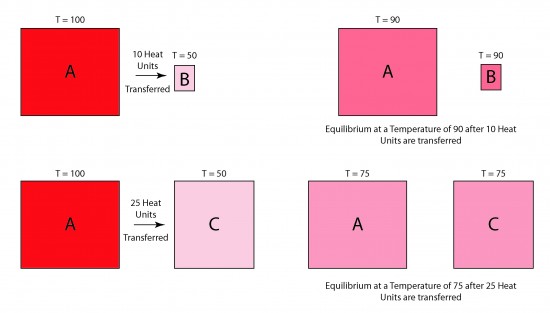Hot air drying applications involve, primarily, the evaporation of water or another liquid such as a solvent from the surface being dried. Evaporation occurs as heated air circulates over and around the surface being dried as discussed in earlier blogs. In all cases this liquid evaporation consumes heat which results in cooling of the remaining liquid. One major consideration in drying, therefore, is how to prevent cooling of the as yet to be evaporated liquid below the temperature that will sustain evaporation until the surface is completely dry. Again, it is important to recognize that heat and temperature although related are two different things.

The addition of heat to an object increases its temperature while the removal of heat results in a temperature decrease. How much a given amount of heat will increase temperature of an object depends on the mass and heat capacity of the object. The rate at which heat moves from one object to another is determined by conductivity and the difference in temperature between the two. Better heat conductors transfer heat at a faster rate than poorer heat conductors. (Poor heat conductors are called insulators.) A greater difference in temperature will increase the rate of heat transfer.
As liquid evaporates at the liquid/air interface, the remaining liquid is instantaneously cooled. Heat to replace that lost to evaporative cooling is supplied from both the hot air and from the surface being dried. As air has a relatively low heat capacity and is a relatively poor conductor, transfer of heat from the air to the liquid is an inefficient process. Increasing the temperature of the hot air will help overcome this inefficiency by speeding up the transfer of heat. However, it is not always possible to increase the air temperature due to the heat sensitivity of the parts.
Note – In a hot air dryer, the part(s) being dried seldom actually reach the temperature of the recirculating air around them due to the inefficiency of heat transfer and the fact that evaporative cooling effectively prevents heating of the part surface above the boiling point of the liquid until all liquid has evaporated. The determination of appropriate dryer temperature limits for parts that are heat sensitive should be made by conducting tests monitoring the actual part temperature using a thermocouple or other means during drying. In most cases, limiting dryer temperature to the temperature limit for the part may not be necessary and may result in excessive drying times. The decision to increase dryer temperature should not be made arbitrarily but only with sufficient test data to support its appropriateness.
As it turns out, the part itself often has a higher heat capacity and better conductivity than air and should be considered as a source of heat for drying. Increasing the amount of heat in a part by using hot rinses may be a good option in such situations. Water, having both a relatively high heat capacity and good conductivity can add heat to a part much more efficiently than air. The use of cold rinses prior to a hot air drying process will result in much more energy being used to supply heat to the part than would be required to supply heat by heating the final rinse. The same amount of heat is required in the end, and that heat can often be provided much more efficiently in the rinse.
– FJF –



 English
English Spanish
Spanish Chinese
Chinese Canada
Canada Mexico
Mexico United Kingdom
United Kingdom



